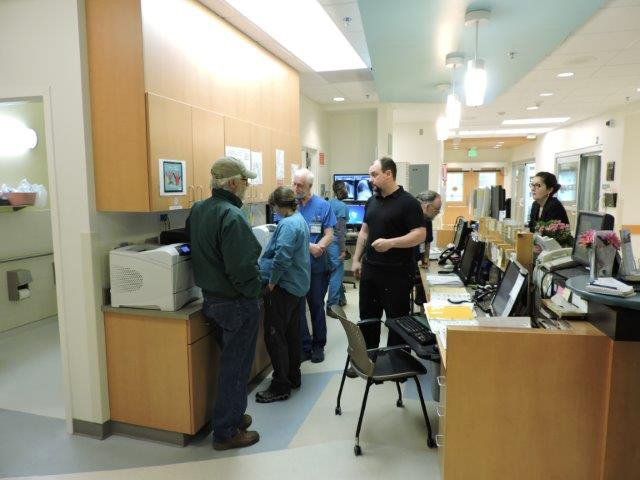New “telemedicine” technology going onto area ambulances transmits patients’ vital signs from the ambulance to the hospital’s computer server, using the same technology and infrastructure as mobile phone signals. If the ambulance goes through an area that lacks cell-phone coverage, the device stores the information until the vehicle gets within signal range.
In many emergencies, every second counts. For a critical patient in rural Alaska, the long drive from that idyllic home in the wilderness to the nearest hospital suddenly looms as a life-threatening problem.
New “telemedicine” technology going onto area ambulances will help. Called the HeartStart Telemedicine System, it will relay patients’ vital signs directly to the South Peninsula Hospital emergency room.
In May, Kachemak Emergency Services (KESA) became the first emergency department in Alaska to use the system, and Anchor Point Emergency Services is installing it now.
“Through information technology we are able to get information to the ER staff,” said Steve Boyle, who spearheaded the project in his role as the assistant chief at KESA. On the southern peninsula, in remote places, on poor roads or during bad weather, it can take more than an hour for an ambulance to bring a patient to the hospital, he said.
The telemedicine system transmits patients’ vital signs from the ambulance to the hospital’s computer server, using the same technology and infrastructure as mobile phone signals. If the ambulance goes through an area that lacks cell-phone coverage, the device stores the information until the vehicle gets within signal range.
The system complements the existing radio communications, allowing medics to focus on the patient and transmitting other important information rather than trying to describe to ER staff what the complex and changing lines on a heart monitor are doing.
Those in the hospital can watch those lines themselves in almost real time and use the information to diagnose the patient’s condition and set up a room, equipment and personnel to spring into action the moment the ambulance arrives at the hospital door. In extreme cases, the hospital can call for a medevac flight to start on its way.
Emergency physicians can watch what is happening with the patient on the moving ambulance. They describe it as like looking over the medic’s shoulder, Boyle said.
Once medics activate the system, it handles all the data and transmission automatically. In addition to monitoring heartbeats, the system transmits information about other vital signs such as blood pressure, oxygen uptake and carbon dioxide exhaled. It also reports “events” such as administering drugs or defibrillating the patient.
Adding the telemedicine system is part of a long-term strategy to obtain flexible equipment to accommodate advances in medical technology, Boyle said.
In 2012, the departments invested in Philips HeartStart MRx monitor/defibrillator units, using state grants available through a program called Code Blue, administered by the Southern Region EMS Council. One reason for choosing the Philips equipment was the option to update it.
This year, the departments were able to purchase the telemedicine transmitters and software upgrade. They paid $1,236.90 and divided that between the two department’s operating budgets, he said.
Travis Ogden is the hospital’s liaison for the project. He volunteers as a KESA medic but also works as a support technician in the hospital’s information technology department. This puts him in a unique position to see the system’s benefit from both sides.
He worked with Boyle to ensure that the hospital met the requirements to install the system and to set up the interface. The emergency department is setting up work stations for viewing the transmitted information.
One of the most important benefits from the hospital’s perspective, Ogden said, is that healthcare providers can see how vital signs are trending before a patient arrives.
Boyle said that the first ambulance run using the new system was May 16. So far, it is working well. For now, KESA is turning the system on for all patients to accustom all its medics to working with the new equipment.
In the long run, however, the departments will use the telemedicine system primarily for patients with problems requiring rapid intervention, such as severe injuries, breathing problems or heart attacks.
“This is going to be for critical cases,” Boyle said.
As of the beginning of June, two KESA ambulances carry the system. Plans are to equip two Anchor Point ambulances and a third one at KESA, Ogden said.
The hospital and departments are still setting up some of the more technical aspects. Ogden said the technicians need to label signals so that, in the unlikely event that multiple ambulances transmit via the system simultaneously, providers can keep straight which information pertains to which patient.
That could be important if there were a mass-casualty incident.
KESA’s Chief Bob Cicciarella said the department’s long-term goal is to provide the best possible service to its far-flung rural clientele.
The telemedicine upgrade is the latest step in that process. KESA is working on reducing response times and has set up what he calls the “sprinter program” that equips medics to carry enough equipment that they can go directly to patients and provide critical first aid before ambulances arrive. Ambulances now also carry equipment to analyze blood samples onboard while in transit. The quicker emergency services and the hospital can deliver care, the better the patients’ chances of surviving.
“As we all know,” he said, “time is critical.”
Shana Loshbaugh is a writer who lives on the southern Kenai Peninsula.



